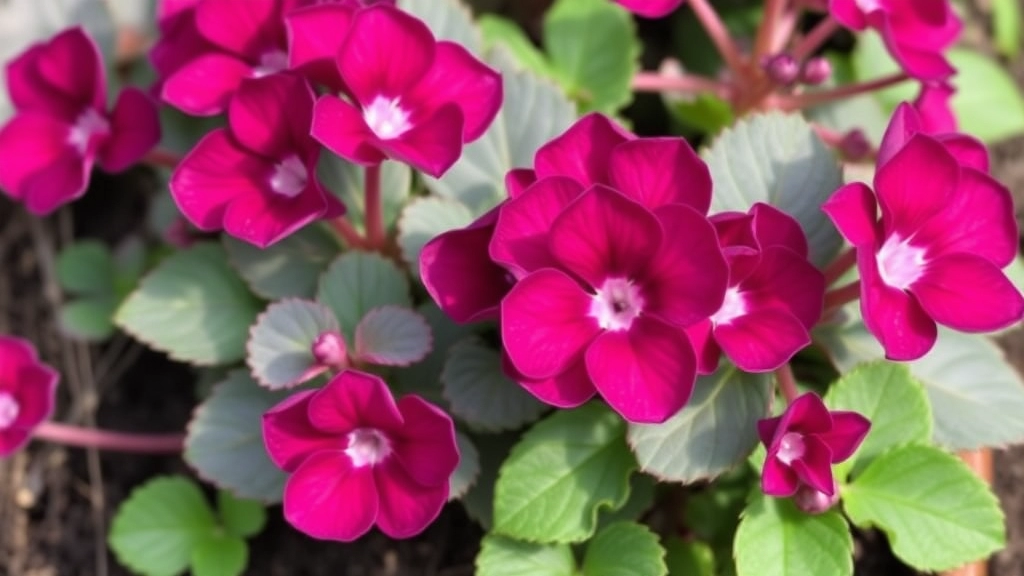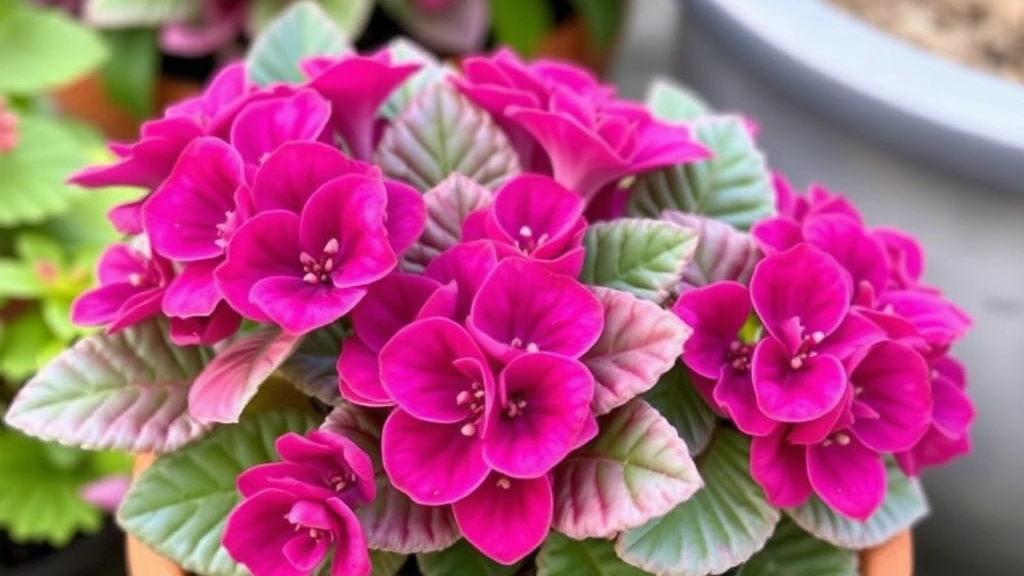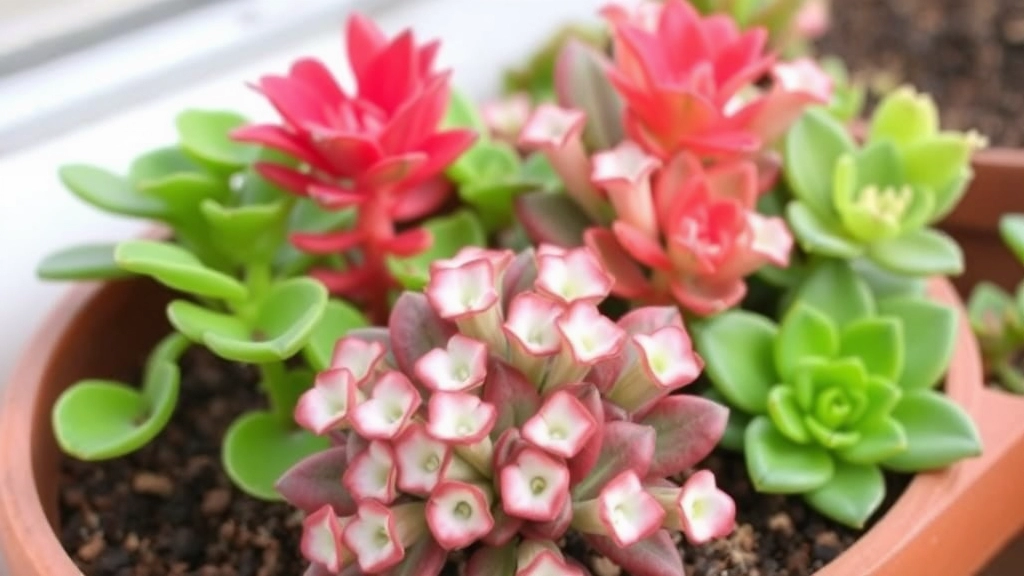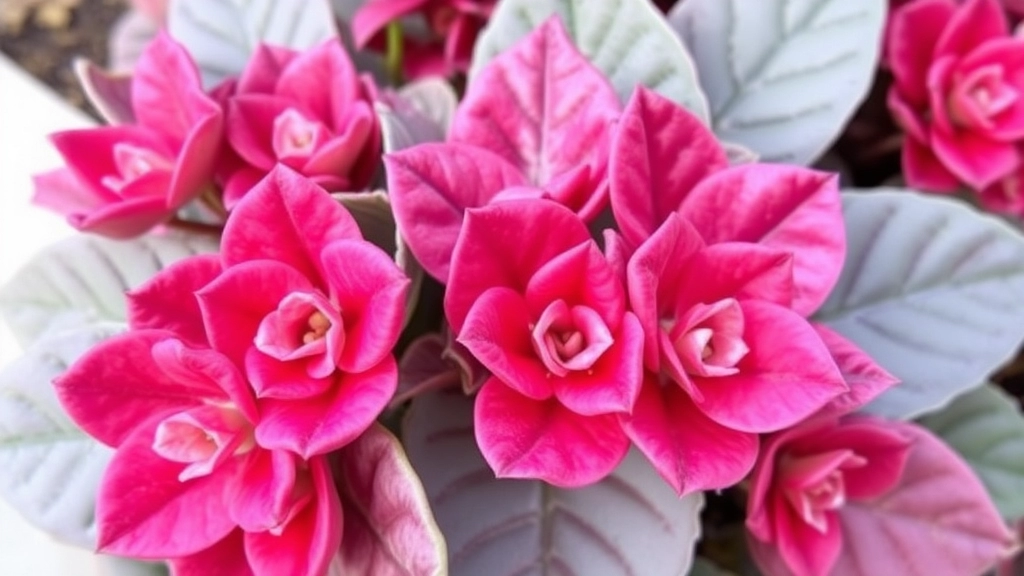Kalanchoe Leaves Turning Purple
Ever noticed your Kalanchoe’s leaves turning a vibrant purple? You’re not alone. As a fellow plant enthusiast, I understand the curiosity and concern that comes with this change. Kalanchoe varieties, like Kalanchoe humilis and Kalanchoe tubiflora, often display stunning purple leaves, either naturally or due to specific care conditions. Let’s dive into the reasons behind these colourful transformations and how to best care for your purple-leafed beauties.
Understanding the Color Change
Understanding why Kalanchoe leaves turn purple can help you provide optimal care. Factors like sunlight, soil quality, watering habits, and temperature play crucial roles in this phenomenon. By adjusting these elements, you can maintain the vibrant hues of your Kalanchoe and ensure their health. Whether you’re troubleshooting issues or simply exploring the appeal of purple leaves, these insights will keep your plants thriving.
## Types of Kalanchoe with Purple Leaves
When it comes to Kalanchoe, many plant enthusiasts often find themselves captivated by the stunning varieties featuring purple leaves. These unique plants not only offer aesthetic appeal but also come with specific care requirements that can enhance their vibrant colouration.
### Popular Varieties
– **Kalanchoe thyrsiflora**: Commonly known as ‘Paddle Plant’, this variety has large, flat leaves with a striking purple edge, especially when exposed to bright sunlight.
– **Kalanchoe luciae**: Often referred to as ‘Flapjack’, its leaves can turn a deep purple hue under optimal conditions, making it a favourite among collectors.
– **Kalanchoe beharensis**: Also known as ‘Chandelier Plant’, it features textured leaves that can develop a purple tint, adding a unique touch to any indoor garden.
– **Kalanchoe tomentosa**: Known as ‘Panda Plant’, this variety has fuzzy, silvery leaves that can exhibit purple tones at the leaf tips, providing a delightful contrast.
Understanding these types of Kalanchoe is crucial for selecting the right plant for your collection. Each variety has its own charm and care needs that can affect the vibrancy of its purple leaves. For more detailed information on how to care for these plants, check out our [complete guide to Kalanchoe paddle plant care](https://planthq.org/complete-guide-to-kalanchoe-paddle-plant-care/) and [how to care for Kalanchoe tomentosa](https://planthq.org/how-to-care-for-kalanchoe-tomentosa-complete-guide/).
Causes of Purple Leaves in Kalanchoe

Ever noticed your Kalanchoe flaunting those stunning purple leaves and wondered why? You’re not alone. Many plant lovers find themselves puzzled by the vibrant hues of their plants.
Stress Factors
One of the main reasons for purple leaves in Kalanchoe is stress. Stress can come from various sources, and here’s what you might want to keep an eye on:
- Light Levels: Too much or too little sunlight can cause a shift in leaf colour.
- Temperature Fluctuations: Extreme temperatures, whether hot or cold, can stress the plant.
- Nutrient Deficiency: A lack of essential nutrients, especially phosphorus, can lead to purple pigmentation.
Environmental Factors
The environment plays a huge role in how your Kalanchoe looks. Here are some key points:
- Humidity: Kalanchoe prefers a dry atmosphere. Excess humidity can lead to stress.
- Soil Quality: Poor or compacted soil can restrict root growth and nutrient absorption, causing colour changes.
Genetic Factors
Sometimes, it’s just in the plant’s genes! Certain Kalanchoe varieties naturally develop purple leaves due to their genetic makeup. This can be a beautiful trait that adds character to your collection.
How Sunlight Affects Kalanchoe Leaf Color
Understanding how sunlight impacts the colour of Kalanchoe leaves is essential for maintaining their vibrant hues, particularly those striking purple shades that many enthusiasts adore.
Best Soil for Kalanchoe with Purple Leaves

When it comes to nurturing Kalanchoe with purple leaves, the right soil can make all the difference. Many plant enthusiasts often wonder about the best mix to ensure their vibrant foliage remains healthy and striking.
Ideal Soil Composition
For Kalanchoe, particularly those with purple leaves, a well-draining soil is essential. Here are some key components to consider:
- Cactus Mix: A pre-packaged cactus or succulent mix is an excellent choice. It provides the drainage Kalanchoe needs.
- Perlite or Pumice: Adding perlite or pumice improves aeration and drainage, preventing root rot.
- Organic Matter: Incorporating a small amount of organic matter, like compost, can provide essential nutrients without retaining too much moisture.
Soil pH
Kalanchoe thrives in slightly acidic to neutral soil, ideally with a pH of 6.0 to 7.0. Testing your soil’s pH can help you adjust it if necessary.
Tips for Potting
- Choose the Right Pot: Ensure your pot has drainage holes to allow excess water to escape.
- Layering: Consider adding a layer of gravel at the bottom of the pot to enhance drainage.
- Repotting: Repot your Kalanchoe every couple of years to refresh the soil and provide it with new nutrients.
By selecting the right soil mix and ensuring proper drainage, you can help your Kalanchoe with purple leaves flourish beautifully.
When it comes to keeping your Kalanchoe with purple leaves thriving, proper watering is essential. Many plant enthusiasts often worry about overwatering or underwatering their beloved succulents.
### Key Watering Guidelines:
– **Soil Moisture Check:** Always check the soil moisture before watering. Insert your finger about an inch into the soil; if it feels dry, it’s time to water.
– **Watering Frequency:** Generally, Kalanchoe prefers a watering schedule of every 2-3 weeks. However, this can vary based on your home’s humidity and temperature.
– **Watering Technique:** Water deeply but infrequently. Ensure that excess water drains out of the pot to avoid root rot.
– **Seasonal Adjustments:** During the growing season (spring and summer), increase the frequency slightly. In winter, reduce watering to allow the plant to rest.
– **Use Room Temperature Water:** Cold water can shock the plant. Always use water at room temperature.
### Signs of Improper Watering:
– **Yellowing Leaves:** This could indicate overwatering.
– **Shrivelling Leaves:** This often points to underwatering.
For more detailed care tips, you can check out the [complete care guide for Kalanchoe synsepala](https://planthq.org/complete-care-guide-for-kalanchoe-synsepala-baker/) or learn about [how to grow and care for Kalanchoe lavender scallops](https://planthq.org/how-to-grow-and-care-for-kalanchoe-lavender-scallops/).
Temperature Requirements for Purple-Leaf Kalanchoe

So, you’ve got a stunning Kalanchoe with those eye-catching purple leaves, but are you wondering if the temperature is just right for your leafy friend?
Ideal Temperature Range
Kalanchoe plants thrive best in a temperature range of 18°C to 24°C (65°F to 75°F).
- Too Cold? If the temperature drops below 10°C (50°F), your plant might start to suffer. You could see those beautiful purple hues fading or even leaf drop.
- Too Hot? On the flip side, if it gets too warm, especially above 30°C (86°F), your Kalanchoe might become stressed.
Temperature Fluctuations
- Consistent Conditions: Kalanchoe doesn’t like sudden temperature shifts. A stable environment helps keep those vibrant purple leaves looking their best.
- Drafts and Heat Sources: Keep your plant away from chilly drafts or direct heat sources like radiators.
Seasonal Changes
- Winter Care: During colder months, consider bringing your Kalanchoe indoors if it’s usually outside.
- Summer Sunshine: In the summer, make sure it’s not in the blazing sun all day.
If you’re nurturing Kalanchoe with striking purple leaves, you might encounter a few common issues that can affect their health and vibrancy. Understanding these problems is crucial for maintaining the beauty of your plants.
One of the most noticeable issues is leaf discoloration. While purple leaves are a sign of health, they can turn yellow or brown due to several factors:
– **Overwatering:** Too much moisture can lead to root rot, causing leaves to yellow.
– **Underwatering:** Conversely, insufficient water can cause leaves to dry out and become crispy.
Kalanchoe can attract pests, which may lead to further complications. Common culprits include:
– **Mealybugs:** These tiny, white pests suck sap from the leaves.
– **Aphids:** They can distort new growth and lead to leaf drop.
Fungal infections can be a concern, especially in humid conditions. Signs include:
– **Black spots** on leaves, often indicating leaf spot disease.
– **Mold** on the soil surface, which can affect root health.
Purple leaves may signal nutrient deficiencies, particularly in:
– **Nitrogen:** This can lead to stunted growth and poor colouration.
– **Magnesium:** A lack can cause leaf yellowing, particularly in older leaves.
Changes in the environment can also impact your Kalanchoe:
– **Temperature Fluctuations:** Extreme heat or cold can shock the plant.
– **Poor Air Circulation:** This can lead to fungal growth and pest issues.
For more detailed guidance on maintaining healthy Kalanchoe plants, check out our [comprehensive guide to caring for Kalanchoe Brasiliensis](https://planthq.org/comprehensive-guide-caring-for-kalanchoe-brasiliensis/) and our [tips for thriving blooms](https://planthq.org/flowering-kalanchoe-care-tips-for-thriving-blooms/).
Propagation Methods for Kalanchoe Varieties

So, you’ve got your stunning Kalanchoe with those eye-catching purple leaves, and now you’re wondering how to propagate it, right?
Propagation is a fantastic way to expand your collection or share with friends. Plus, it’s pretty straightforward. Here are some methods you can try:
1. Leaf Cuttings
- Choose a Healthy Leaf: Look for a plump, healthy leaf.
- Cut and Dry: Cut it off and let it sit for a day or two to callous over.
- Planting: Place it in well-draining soil, and keep it lightly moist.
- Wait for Roots: In a few weeks, you should see roots forming.
2. Stem Cuttings
- Select a Stem: Pick a healthy stem with a few leaves.
- Make the Cut: Cut just below a leaf node.
- Callous: Allow the cut end to dry for a day.
- Plant: Stick it in soil and water lightly.
- Watch for Growth: New leaves will sprout in a few weeks.
3. Offsets
- Look for Offsets: Some Kalanchoe varieties produce offsets (baby plants).
- Gently Remove: Carefully separate them from the parent plant.
- Replant: Place them in their own pots with suitable soil.
4. Seeds
- Gather Seeds: If your Kalanchoe flowers, you can collect the seeds.
- Sow: Plant them in a seed tray with a light soil mix.
- Moisture: Keep the soil slightly moist until they germinate.
Propagation is not just about expanding your plant collection; it’s also a rewarding experience. Watching those new plants grow is like seeing a little piece of your gardening journey flourish.
Toxicity Concerns for Pets and Purple-Leaf Kalanchoe
As we delve deeper into the care of Kalanchoe, it’s crucial to address a significant concern for pet owners: the potential toxicity of purple-leaf Kalanchoe.
Many plant enthusiasts often wonder, “Is my Kalanchoe safe for my pets?”
The answer is a resounding noâKalanchoe can pose health risks to cats and dogs.
Understanding the Toxicity
Kalanchoe contains compounds called bufadienolides, which can be harmful if ingested.
- Symptoms of Toxicity:
- Vomiting
- Diarrhoea
- Lethargy
- Abnormal heart rhythms
If you suspect your pet has ingested any part of the plant, it’s essential to consult a veterinarian immediately.
Preventative Measures
To keep your furry friends safe, consider the following tips:
- Placement: Keep Kalanchoe out of reach of pets.
- Alternatives: Opt for pet-friendly plants if your home is shared with animals.
- Education: Teach your pets to avoid certain houseplants.
For more detailed information, you might want to read about the toxicity of Florist Kalanchoe to cats and how to fix issues with soft Kalanchoe leaves.
FAQs about Kalanchoe Purple Leaves
Why are the leaves of my Kalanchoe turning purple?
The purple leaves in Kalanchoe can be attributed to several factors including stress from light levels, temperature fluctuations, and nutrient deficiencies. Additionally, environmental factors like humidity and soil quality, as well as genetic traits, can cause this color change.
What kind of soil is best for Kalanchoe with purple leaves?
A well-draining soil is essential for Kalanchoe, especially those with purple leaves. A cactus or succulent mix, along with perlite or pumice for added aeration, and a small amount of organic matter, works best. The pH should ideally be between 6.0 and 7.0.
What is the ideal temperature range for Kalanchoe with purple leaves?
Kalanchoe thrives in temperatures between 18°C to 24°C (65°F to 75°F). Temperatures below 10°C (50°F) or above 30°C (86°F) can stress the plant, affecting its vibrant leaf color.
How should I care for my Kalanchoe during seasonal changes?
In winter, bring your Kalanchoe indoors if it’s usually outside. During summer, ensure it’s not exposed to direct, intense sunlight all day. Avoid sudden temperature shifts and keep it away from drafts and direct heat sources.
What are the propagation methods for Kalanchoe?
Kalanchoe can be propagated through leaf cuttings, stem cuttings, offsets, and seeds. Each method involves specific steps, such as allowing cuttings to callous before planting and ensuring well-draining soil for new growth.
1. Leaf Cuttings
Choose a healthy leaf, let it dry for a day or two, then plant it in well-draining soil.
2. Stem Cuttings
Select a healthy stem, cut below a leaf node, allow it to callous, and then plant it in soil.
3. Offsets
Carefully remove offsets from the parent plant and replant them in suitable soil.
4. Seeds
Collect seeds from flowering Kalanchoe, sow them in a light soil mix, and keep the soil moist until germination.
Propagation is a rewarding way to expand your plant collection and enjoy the growth of new plants.
References
-
Why Are My Kalanchoe Leaves Turning Purple?
-
How to Grow and Care for Kalanchoe
-
Kalanchoe Plant Care
